Cruisers are confronted with so many choices when it comes to binoculars and for the most part, the expensive ones look very similar to the inexpensive. So how do you know which binoculars are best? The answer varies for different boats and different cruising grounds.
We have three different types of binoculars aboard – 7 X 50 weatherproof binoculars with a built in compass and light, 7 X 25 waterproof lightweight hiking & exploring binoculars and a pair of Nikon Stabil-Eyes 8 X 32 stabilized binoculars.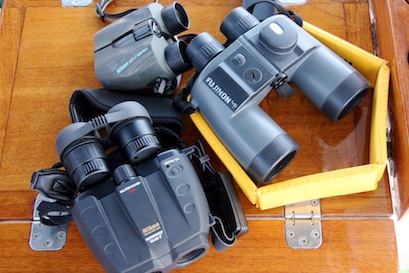
A good pair of weatherproof, preferably waterproof, 7 X 50 binoculars with a built in compass and light turned out to be the best investment we made in binoculars. They’re the ones we use ALL the time, and have replaced them once because we literally wore them out … the compass didn’t work anymore, the light didn’t light anymore … the visuals were still good, but the compass and light are important to us.
If you’re not familiar with binocular lingo, the first number in the set is the magnification, so our “7” X “50”s have 7 times magnification. The second number is how much light is let in – larger numbers let in more light. We notice this mainly in our spotting scope, but not so much in the binoculars. To be sure we tested a few pairs that were noticeably less clear, but whether it was due to lower light being let in or inferior optics, we don’t have a clue.
In general, more expensive binoculars have better glass or optics, which usually translates into clearer vision. The larger size 7 X 50 captures more light in a wider field of vision, allowing you to see a larger area clearly in a wide variety of light conditions, including low light. If you’re looking through binoculars, you’re probably trying to see something far away, clearer vision emerges as an imperative.
When deciding on our initial Fujinon 7 X 50 binoculars, we found it helpful to visit West Marine and REI and literally look through as many pairs as we could. While the most expensive brands did have somewhat better optics, they weren’t enough better than the Fujinon’s to influence our decision or justify buying a higher priced pair.

We really like the float strap on ours – while it can get in the way, we like the idea if we accidentally drop them overboard… maybe they’d float long enough for us to grab them.
Why a compass inside? Isn’t that just a distraction? The compass inside helps navigate in marked waters. With a mere glance though the binoculars, the observer can easily see the next marker and also that it’s bearing 110 degrees (translation – turn to 110 degrees – but don’t HIT the marker!).
I know we’re old fashioned, but with all the fancy anchor alarms available today, we still prefer the bearings mething of making sure we’re not dragging. Take a bearing on various points with a quick glance through the binoculars. “Radio tower bearing 110 degrees, green flashing marker at 270 degrees and white church steeple at 10 degrees.” Make sure all the bearings selected are far enough away not to change when the boat swings at anchor. It’s also good to pick a point that will be visible in the darkness of the middle of the night at a glance. Remember you can’t read a compass in binoculars at night unless there’s either a light or the compass glows inside. Write them down on and keep them handy just in case a recheck is necessary to make sure you’re still in the same place.
The second most used pair of binoculars aboard are 8 X 25 Nikon waterproof hiking/exploring binoculars. Although these are frequently used as a second pair of eyes while navigating, we originally added them for birdwatching, hiking and other exploring. They are compact, lightweight and waterproof, making them perfect to take in the dinghy, kayaks or hiking. There’s no bigger thrill for us than spotting a far off sloth leisurely making his way along a branch in the rainforest or a brightly colored toucan sitting still pretending he’s hiding!
The third pair of binoculars we have aboard were a last minute addition – Nikon Stabil-Eyes 12 X 32 waterproof image stabilized binoculars. We found in the six years we cruised outside U.S. waters, we NEVER removed them from the electronics locker. There weren’t enough marked channels to make them useful. They do make a big difference in how soon we can accurately read markers and signs, but the other binoculars provide the information soon enough for safety.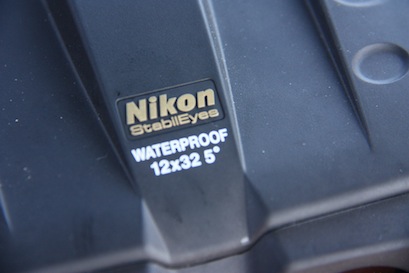
Now that we’ve returned to the U.S., we use them occasionally to help spot channel markers, but more often to read the names on boats coming into a large anchorage. Not something worth the investment, but fun to have aboard. We did have to send them back after a few years to Nikon to get them refurbished because they apparently didn’t like the salt air. But it didn’t cost much and they’re fully functional again. If you have a pair, make SURE to take the batteries out before leaving the boat for any period of time or you’ll end up with a burst battery and battery acid everywhere!
So what binoculars do you have aboard? Any recommendations for those outfitting their cruising boat? Please leave a comment and share. Cheers! Jan

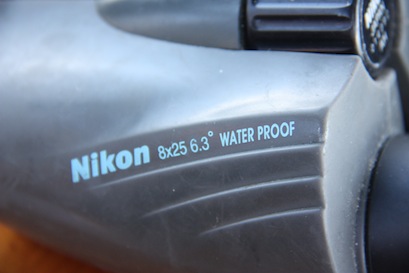
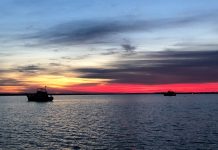
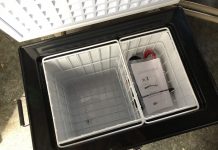
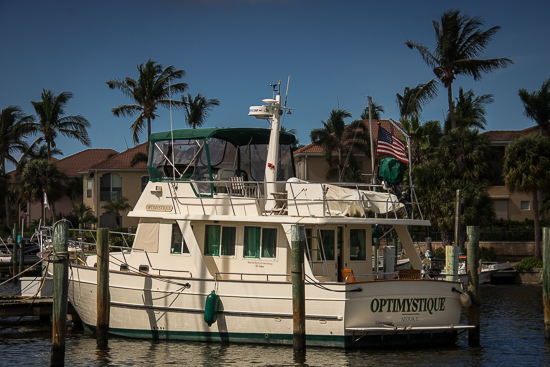







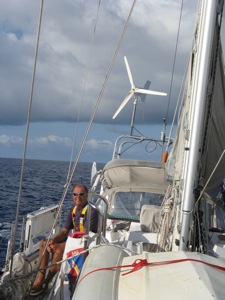
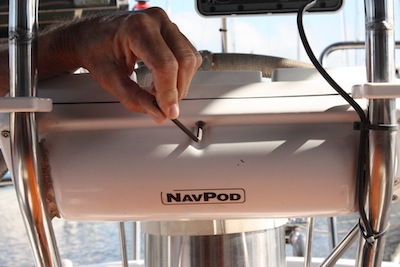

Great Blog! The correct binoculars can enhance many experiences in life, bringing you closer to the action and allowing you to view details in the world. A good pair of binoculars has to be a great asset for photographic shoot, boating, butterfly watching, sporting events etc. Binoculars use a combination of glass elements to enlarge a scene.
First of all, Thanks for such a great article about Best Binoculars for cruising available on Today’s Market. Your article helped me to pick the right one, After reading it, I am going to choose NIKON 8×25 from Your List. What do you say about my choice?